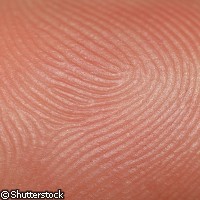Scientists put their finger on fingerprints' role in touch
Our fingerprints play a vital role in allowing us to feel fine textures that are just a fraction of a millimetre across, according to new EU-funded research published online by the journal Science. EU support for the study came from the MONAT ('Measurement of naturalness') project, which is financed through the NEST (New and emerging science and technology) budget line of the Sixth Framework Programme (FP6). The ability of our hands to carry out high-precision tasks such as grasping and manipulating objects, detecting minute flaws on the surface of objects and discriminating between different textures, relies on the tactile sensitivity of our fingertips. Tactile information is detected and transmitted to our brain by different kinds of dedicated nerve endings. Coarse textures, whose dimensions are larger than 200 micrometres (i.e. one fifth of a millimetre, or roughly the width of a human hair) are picked up by mechanoreceptors. Finer structures are detected by Pacinian corpuscles, which pick up the vibrations generated when the fingertip is passed across a surface. The Pacinian corpuscles are in turn connected to sensory neurons, which relay the information to the brain. In this latest study, the scientists investigated the role played by the ridges and valleys of our fingerprints in relaying textural information to the Pacinian corpuscles. To do this, they created a mechanical tactile sensor whose dimensions match those of a human fingertip. A stretchy, elastic cap covered this fake fingertip. The surface of this cap could be either smooth or patterned with ridges to mimic a human fingerprint. When the fingerprinted sensor was moved across randomly patterned surfaces, the ridges of the 'fingerprint' appeared to amplify and filter certain frequencies of vibrations to generate a signal that nicely matched the sensitivity spectrum of the Pacinian corpuscles. The smooth-capped sensor did not elicit the same effect. According to the researchers, this signal amplification process depends strongly on the orientation of the ridges with respect to the direction in which the finger is moving. The fake fingerprint used in the experiment consisted simply of parallel lines of ridges; during the experiment, these ridges were oriented perpendicularly to the direction of movement. However, the researchers note, the ridges of real fingerprints are organised in elliptical swirls. In effect, this means that each region of the fingerprint (and therefore each Pacinian corpuscle) is optimally aligned according to the scanning direction. 'Further studies are needed in order to elucidate how this may reflect on the exploratory procedures (such as fingertip trajectory and contacting zone) used by humans during texture evaluation tasks,' the researchers write. Creating an artificial fingertip was a major aspect of the MONAT project, which began in 2006 and is scheduled to end later this year. The project aims to understand how people use their senses of sight and touch to distinguish between natural and synthetic materials. The issue has great commercial importance; many products made from natural materials like silk, cashmere, leather or oak for example, are prized as luxuries. Designing synthetic versions of these materials that both look and feel the same as the original is extremely challenging. The information generated by the MONAT project will help materials experts meet this challenge and create items that not only have the low cost and durability of synthetic materials but also the look and feel of natural materials.
Countries
France



